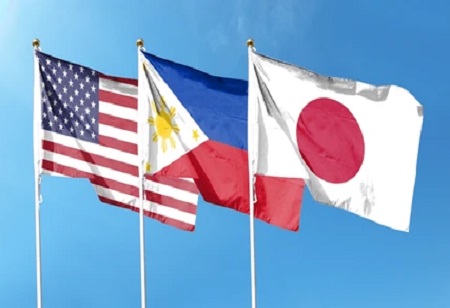
US, Japan are interested to Fund $15 Billion for Philippine Projects as Ties Grow

 Japan and the US are interested to fund at least an amount of $15 billion worth projects on the Philippines’ main island, in signs that enhanced security ties are leading to greater economic benefits, according to President Ferdinand Marcos Jr.’s investment czar.
Japan and the US are interested to fund at least an amount of $15 billion worth projects on the Philippines’ main island, in signs that enhanced security ties are leading to greater economic benefits, according to President Ferdinand Marcos Jr.’s investment czar.
The three nations will prioritize five major projects in the Luzon Economic Corridor plan which may well turn out to be Marcos’ flagship investment program, said Secretary Frederick Go who advises the president on the economy. The list includes a cargo rail linking Luzon’s major ports estimated at $11 billion and a renewable energy project, he said.
“We are reaping the benefits of closer defense ties with the US and other allies in terms of promoting investments,” Go said in an interview Monday. The UK is also interested to help fund projects in the corridor, he added.
The Philippines, which lags neighbors in attracting overseas investments due to infrastructure gaps and friction costs, is seeking to leverage stronger ties with the US and its allies under Marcos to help unlock economic benefits. The push comes as competition in the region intensifies, with Washington and other Western nations aiming to diversify supply chain sources and reduce their exposure to China.
The plan to reinvigorate Luzon, the country’s main economic engine where the capital sits, was unveiled after US President Joe Biden met with leaders from Japan and the Philippines in April. The three allies are bolstering economic ties as their defense relations grow in the face of Beijing’s assertiveness in the region.
The Philippines’ alliance with the US is expected to remain strong whoever wins the presidential race in November, Go added that, the goal is to start the five Luzon corridor projects during Marcos’ term which ends in 2028, he added.
Faster gross domestic product growth, possibly exceeding 7% annually is achievable in the next four years, said Go, as Marcos aspires to shift the economy from being consumption-led to one that’s driven by investment.
Catching up with the neighbouring countries in terms of investments has eluded many Philippine presidents. What’s different this time around, according to Go, is that the administration is capitalizing on Marcos’ foreign policy agenda to benefit the economy. Part of Go’s task is to provide the follow-through that’s needed to ensure that investment pledges actually materialize.
“This is why I’m focusing on improving ease of doing business and reducing the cost of doing business because they are the key pillars to realizing an investment-led growth”, said Go, former president of Robinsons Land Corp. before taking on the government post.
Some early signs are promising. There’s $1 billion in investment commitments from American businesses during a Biden-initiated trade mission in March. The nation also recently opened up more sectors for foreigners, which also include renewable energy. GDP expanded 6.3% last quarter, among the highest in Southeast Asia, as investments grew by double digits.
Yet other growth drivers have been unstable, with consumption posting the very slow post-pandemic growth in the first two quarters and government spending hampered by limited fiscal space. Signs of strain in the economy are putting the onus on Marcos to lure more investments.
One bright spot for investments is the 'Create More' bill which seeks to reduce corporate income taxes and put policies including incentives at par with neighbors.
Go is paying special attention to the electronics and semiconductor sector as it accounts for the country’s biggest goods exports. He’s hoping that 'Create More' will usher in more investments in that area. “We have to play in a field where we are good at,” he said. “At the same time, we should benchmark ourselves with the best in the world to become more competitive”, he said.

